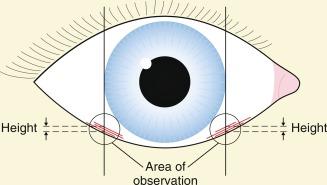Physical Address
304 North Cardinal St.
Dorchester Center, MA 02124
Lid-parallel conjunctival folds (LIPCOFs) are sub-clinical folds in the lateral, lower quadrant of the bulbar conjunctiva, parallel to the lower lid margin, which are easily observable with the slit lamp biomicroscope ( Fig. 12.1 ). This phenomenon, first described by Hoh et al. in 1995, has received considerable attention in the literature since then. LIPCOFs are not an adverse ocular reaction; rather, it is a sign of dry eye, including contact lens-associated dry eye.
LIPCOFs are assessed at two specific locations where they manifest most clearly. These locations are just above the lower lid margins, at points where an imaginary perpendicular line projects from the nasal and temporal extremities of the cornea. LIPCOFs appear as one or more linear folds which are 3 to 4 mm in length and are parallel to the lid margin and generally parallel to each other.
The preferred observation technique using the slit lamp biomicroscope is as follows. LIPCOFs can be assessed with or without contact lenses being worn. The patient is instructed to gaze straight ahead. Fluorescein or any other dye should not be instilled, as LIPCOFs are best observed in white light. A magnification of around × 25 is selected and, in the first instance, a narrow vertical beam is aligned with the nasal or temporal cornea. LIPCOFs can be observed at the inferior lid margin ( Fig. 12.2 ). The linear folds can be inspected in both direct and indirect illumination (in the latter case, on either side of the beam). The height of the fold, or series of folds, should be recorded in millimetres.

The observation of folds can be further enhanced by rotating the slit beam so that it is parallel with the folds and the lid margin. The slit beam is positioned above the folds, which can be seen in indirect illumination. Examples of slit lamp illumination techniques for observing LIPCOFs are shown in Fig. 12.3 .

The severity of LIPCOFs can be determined by counting the number of folds and assigning a grade accordingly, as shown in Table 12.1 . Examples of grades 1 and 2 LIPCOFs are shown in Fig. 12.4 . A further combined LIPCOF score (LIPCOF Sum) can be calculated by adding together the nasal and temporal LIPCOF grades.
| Description | LIPCOF grade |
|---|---|
| No conjunctival folds | 0 |
| One permanent and clear lid-parallel fold | 1 |
| Two permanent and clear lid-parallel folds | 2 |
| Three or more permanent and clear lid-parallel folds | 3 |

Anterior segment optical coherence tomography offers a non-invasive, high-resolution method of imaging, evaluating and classifying LIPCOFs. Veres et al. devised three different algorithms to grade LIPCOFs according to tear meniscus height of the covering tear film on the folds, which showed significant correlation with the slit lamp method (r = 0.470–0.473, p < 0.01). By using this technique, the number of folds can be observed, and various physical dimensions of LIPCOFs can be determined ( Fig. 12.5 ).

Tapaszto et al. used Fourier-domain optical coherence tomography to assess alterations in LIPCOF morphology in the eyes of contact lens wearers; these assessments were repeated after removal of the contact lenses. The presence, height and number of conjunctival folds and the tear meniscus area were evaluated. The authors observed that after removal of the contact lens, the height of the LIPCOF significantly decreased (p < 0.001) and the tear meniscus area significantly increased (p = 0.017). Although the number of LIPCOFs did not change (p = 0.971), LIPCOF coverage by the tear film increased after lens removal.
These results suggest that when grading LIPCOFs, the mechanical forces of the lens and the tear meniscus should be taken into account. Thus, repeated measures over time should all be taken using the same protocol (i.e. either all with contact lenses or all without contact lenses).
Become a Clinical Tree membership for Full access and enjoy Unlimited articles
If you are a member. Log in here